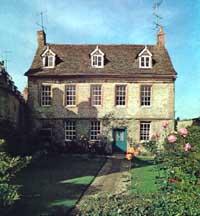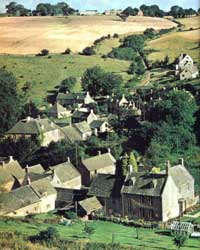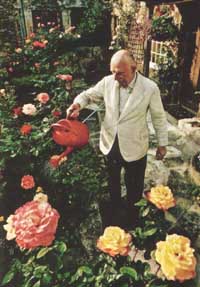by Chalerm Raksanti
This little slice of English heaven has often been
called the nicest part of the country. The soul of the Cotswold lingers in
unchanging villages that nestle on the region’s hillsides. Tiny
gray-walled Naunton, for example, dates from at least the 12th century.
Lying in the Cotswold heartland and officially designated as an Area of
Outstanding Beauty, the village guards her medieval ancestry carefully.
Even new structures in the tranquil hamlet must harmonize with the
centuries-old stone buildings already there.
 Classic
and courtly, a home in Cirencester proclaims its local heritage by the
square stoned walls and titled roof.
Classic
and courtly, a home in Cirencester proclaims its local heritage by the
square stoned walls and titled roof.
All the picture-postcard parishes wear the visage of
the past. These ancient communities of grayish and straw-yellow stone are
as mellow as the fields of stubble after harvest. Snuggled into the
sweeping hills, looking out on vast, unsullied panoramas, they are stamped
with the mark of genuine Middle Ages even though they sit right on the
edge of England’s teeming southeast where nearly a third of the UK’s
population lives.
The Cotswolds themselves were created millions of years
ago when an ancient seabed reared up to form a great escarpment. It runs
northeast for nearly 60 miles from just above Bath, and it is awesomely
vertical along the western edge which reaches an elevation of 1,083 meters
at Cleeve Hill. The ridge is solid limestone of a type called oolite (eggstone)
because its small round granules resemble roe. From prehistoric times the
locals have built with the eggstone and its honey tones give the Cotswold
their all pervasive character, harmonizing village with village, early
centuries with those which came later.
 Unchanged
Naunton nestled in the hillsides dates back from the 12th century.
Unchanged
Naunton nestled in the hillsides dates back from the 12th century.
Stories about Queen Elizabeth I abound in the Cotswold,
much of it colorful gossip, but it was no accident that Henry VIII had a
castle here. He was keeping his eye on his assets. During the 13th and
14th centuries wool was the basis of English wealth, and she became the
world’s greatest wool exporter. Cloth making in the Cotswold centered in
the south and the name Cotswold may derive from “wold” which means
high open land, and “cotes” which are sheep shelters.
Stone masons in Cotswold will tell a visitor, “A true
Cotsaller can do anything with stone except eat it.” The splendor of the
stonework in the villages testifies to the great craftsmanship through the
ages. Of course nowadays, since the stone has dwindled, modern techniques
have replaced quarried stone, but still retain the crucial beauty. Within
the bounds of the ‘beauty area’ stone is all but mandatory.
 Loving
care goes into this over-flowing English rose garden set in the medieval
backdrop of a stone cottage in Chipping Campden.
Loving
care goes into this over-flowing English rose garden set in the medieval
backdrop of a stone cottage in Chipping Campden.
The Cotswold is also the stomping ground of the horsy
set and five hunts through the season provide competitions. This
region’s involvement with horses came in the last quarter of the 18th
century when towns like Buford, Stow on the Wold, and Northleach were
junctions of main coaching routes linking the West Country with Oxford and
London. Around the clock, the coaches galloped down the towns’ high
streets with long brass horns blowing to warn pedestrians.
Of course today a new coaching era has arrived at the
Cotswold. Through the summer buses disgorge day trippers and sightseer’s
cars choke the narrow streets. Such is the fate of some of the most
beautiful villages in the heart of the Cotswold. But, thankfully, the far
southern reaches promote little tourism and only a few miles out of the
‘beauty bounds’ a traveler will still find intriguing towns to
explore.

 Classic
and courtly, a home in Cirencester proclaims its local heritage by the
square stoned walls and titled roof.
Classic
and courtly, a home in Cirencester proclaims its local heritage by the
square stoned walls and titled roof. Unchanged
Naunton nestled in the hillsides dates back from the 12th century.
Unchanged
Naunton nestled in the hillsides dates back from the 12th century. Loving
care goes into this over-flowing English rose garden set in the medieval
backdrop of a stone cottage in Chipping Campden.
Loving
care goes into this over-flowing English rose garden set in the medieval
backdrop of a stone cottage in Chipping Campden.
